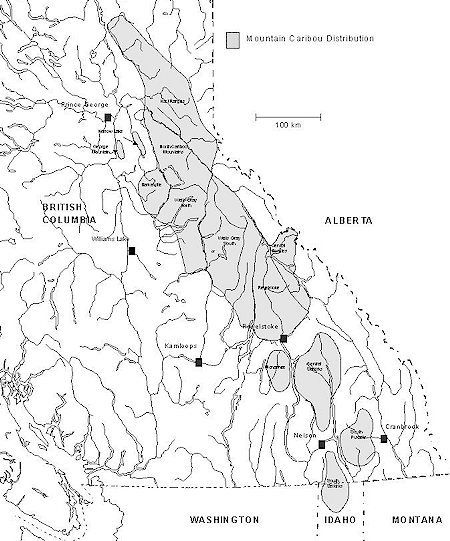Mountain caribou information sheet (2004)
- by Michael Morris, Mount Revelstoke and Glacier National Parks
- July 2004

Mountain caribou cow and calf, Mas Matsushita photo
Although they are the same subspecies as woodland caribou once found throughout boreal Canada, the mountain caribou’s different use of habitat makes it an ecotype unique to the mountains of the interior wet belt of south-eastern British Columbia. Mountain caribou are recognized by the Committee on the Status of Endangered Wildlife (COSEWIC) as part of the threatened “Southern Mountain population” of Woodland Caribou. Threatened populations are considered likely to become endangered if limiting factors are not reversed. Census results from 2004 show declines of 50% over the past decade among the herds of mountain caribou across the southern portion of their range.
Caribou Ecology
Mountain caribou have evolved a unique strategy to cope with the deep snow of the Columbia Mountains, migrating vertically twice per year. They spend the late fall and early winter at low elevations, more so than other caribou in British Columbia or Alberta. The closed canopy of old growth forests intercepts much of the early season snow, making it easy for caribou to find ground forage including mountain boxwood (Pachistima), a favourite evergreen shrub.

Mountain caribou browsing on Pachistima, which is accessible because of the snow interception provided by large, old-growth trees.
As the snowpack deepens, digging for food uses more energy than is gained. Caribou move upslope in midwinter, unlike any other ungulate, seeking lichens (principally Alectoria and Bryoria) that grow on trees. But lichens grow slowly. For there to be sufficient amounts of accessible lichen, caribou need old trees. The combination of winter storms and snow laden branches result in lichen being blown off of trees or entire trees blowing over, providing caribou a feeding opportunity. This is more likely to happen in an old growth stand where the trees are rotten enough to fall over, or the branches are rotten enough to snap off.
By March, caribou are in the subalpine forest in places such as the summit of Mount Revelstoke, where a three or four metre snowpack is typical. Though not much bigger than deer, caribou have feet as large as moose and are able to spread their hooves and dew claws to act as small snowshoes. The deep snowpack lifts caribou to lichens on the trees they could not otherwise reach. Lichens alone maintain caribou through the last part of the winter.
In spring, as soon as plants green up at low elevations, caribou head down to the valley bottoms for something fresh to eat, returning to the alpine meadows again for the summer. To avoid predators, pregnant cows return to higher elevations earlier than males, before the snow is gone, to calve individually in remote locations.
Resource Management
Superbly adapted for snow and cold with their large hooves and insulating coat, caribou would have been among the first animals to return to this part of the world at the end of the last Ice Age, around 9,000 years ago. Their numbers declined here after the completion of the Canadian Pacific Railway made hunting them for market possible. Conservation measures introduced in the 1930s placed limits on caribou hunting, but their numbers never fully recovered. Hunting caribou in the Columbia region ceased entirely in 1996.
Since the 1970s, hydroelectric reservoirs and logging have reduced low elevation old growth forest habitat. The scattered remaining bits of habitat take more energy for mountain caribou to access and traveling exposes them to more hazards. Accidents with avalanches and terrain features where the leading cases of mortality among radio-collared caribou in a seven year study in the 1990s.
The past decade has also seen a rapid expansion of snowmobiling and helicopter skiing in the subalpine zone, increasing the disturbance in the mountain caribou’s late winter habitat. Research results from radio-collared caribou indicate that accidents, particularly avalanches, are the main cause of mortality.
In an effort to manage resources on an ecosystem basis, Parks Canada has participated in mountain caribou research and monitoring projects with provincial agencies since 1992. Partners in research include the BC Ministry of Forests, the BC Ministry of Water, Land, and Air Protection, and the Columbia Basin Fish and Wildlife Compensation Program.
Census Results

Mountain caribou researchers have identified discreet herds of caribou in southeastern BC.
The Revelstoke herd is defined as those caribou on either side of the Revelstoke Reservoir from Mount Revelstoke National Park to Mica Creek, and from Glacier National Park on the east, to the height of land in the Monashee Range to the west. This herd has declined from an estimated 373 animals in 1994 to an estimated 176 caribou in 2004.
After ten years of monitoring, biologists know this group well enough to differentiate separate bands with the larger population. The bands with the greatest decline are those that reside closer to Revelstoke than Mica Creek. The Downie-Mount Revelstoke band, for example, is down 69% in the past decade to 38 caribou.
Caribou are counted from the air during the late winter when they are easy to see in the upper subalpine forest. Previous studies using radio-collared animals in this region show that about 90% can be counted in this manner during winters with a snowpack of greater than 3 meters. The survey area is held constant from year-to-year and counts are not conducted in low snow years.

